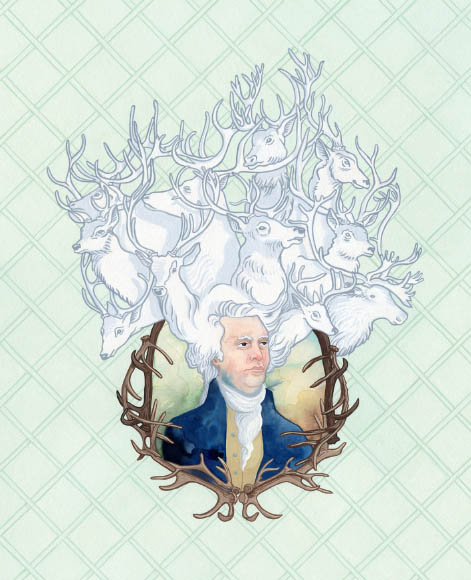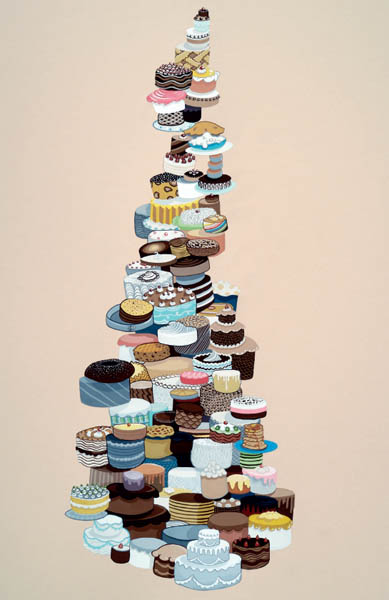Justin Richel was raised in an artistic family, where his creativity was encouraged and allowed to flourish. He received a BFA from Maine College of Art (MECA) in 2002, and in 2004 he briefly studied the technique of icon painting with two Franciscan monks from Lithuania. Quite the education! He is now a full-time illustrator/painter based in Rangeley, Maine (and happens to be married to paper-artist Shannon Rankin, who is also featured in this book). Justin has sold and exhibited his work all over the world.
JC—Most of your paintings are beautifully complex compositions of stacked objects. Why?
JR—The stacks and columns are about perfection, balance, fragility, and the impossible. I began thinking of them as a parallel to the Greek Corinthian columns from which Western society has gleaned its visual, moral, and political aesthetic. They also allude to other traditions of this form, such as the totem pole.
JC—Your chairs, and birds, and furniture—do they come from your imagination, or do you source images to use as inspiration?
JR—The imagery starts in my head, and I then look for source imagery to build the image from a thought to a sketch. I use source imagery because I want the work to have a strange sense of the familiar; I also don’t trust the direct expression of my hand. By that I mean it is too direct when I work from thought to hand: I am looking for that distance. I like to allow the found imagery to shape the outcome.
JC—Which artists have influenced your work? In other words, who makes you “jealous”?
JR—There are so many artists whose life and career have shaped my own. I am so bad at making decisions, so here are my top six. I’ll start with who makes me the most jealous, and work down:
1–2. Andy Warhol or Hokusai—not sure which is first.
3. Joseph Beuys, because he created a mythology and was transformed (like a shaman) through the process of art-making.
4. Marcel Duchamp, because in his later years he gave up making art to play chess.
5. Brancusi, for his pursuit of form and physical harmony inherent in the material itself.
6. The artist who placed the first paintings on the cave walls in El Castillo, Spain, some forty thousand years ago.
JC—Considering how detailed your paintings are, would you ever throw one out if you weren’t happy with it?
JR—There was a time when I would make a single mistake and throw an entire painting away. It’s taken me a long time, but I have finally embraced my mistakes as learning experiences. I now take the “failed paintings” and cannibalize them: cut them up into collage material and recycle them back into my work. I realize how much time goes into a single work, and to throw it away now just seems ridiculous.
JC—Do you feel pressure, as a full-time artist, to be creative all of the time?
JR—The daily requirement to be creative can be difficult to manage. I have several series that I work on and this can be helpful to switch back and forth between series to keep myself interested and engaged. However, I find that I am always craving some form of creative outlet, yet creating art doesn’t always fulfill that need. Thankfully, I have a garden to put my energy into. Gardening is a creative act, yet a different experience than art-making. It’s a kind of collaboration with nature, where the gardener and nature can meet each other halfway.
JC—Is your inner critic allowed into your studio?
JR—My inner critic used to have a prominent and cushy seat in my frontal lobe; however, he has since been demoted to a consultation status only. My inner critic has no place in my studio while I’m working. I’ll bring him in on the conversation once I have something to show him. I like my inner critic—he has his time and place, however, just not while I’m in a creative state of mind.
JC—What is your best advice for getting past a creative block?
JR—I like to call it “pushing through the pain.” I need to finish one piece in order to know what’s next. So even if things are going poorly I continue to work. Finding out what I don’t like is just as important to discovering what works.
Also, it seems obvious enough, but it helps to keep your space clean. When I begin to notice my judgment cloud, or my productivity slow, it’s typically because I need to clean up my space. After a good burst of productivity my work surface is covered in debris. This is important for productivity, but I don’t want those things creeping into my periphery and influencing my decisions on new work.
And if all else fails, having a deadline can motivate like nothing else! It’s that “all or nothing” feeling that can inspire you to pull it together. If you don’t have a gallery exhibition or illustration deadline, ask a friend to give you an assignment. This will help get past the inner block that you have placed on yourself.

My inner critic has no place in my studio while I’m working. I’ll bring him in on the conversation once I have something to show him.
